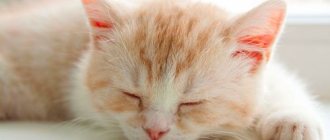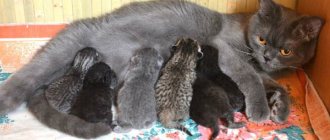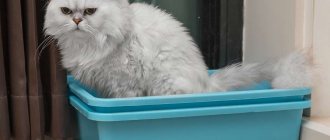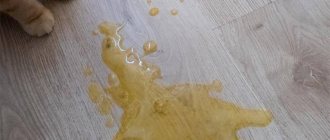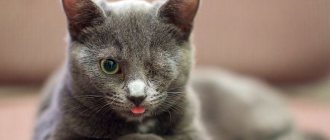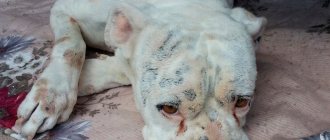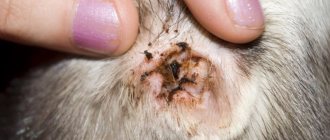Main reasons
The gag reflex always goes through 3 stages:
- Nausea. Accompanied by drooling, increased swallowing, licking the nose and lips. These are the first signs that your cat is about to vomit.
- Belching. The food is pushed up the esophagus and air comes out of the upper stomach.
- The contents of the stomach are released through the mouth. The duration of the process depends on the reasons.
Vomiting in a cat can be a consequence of toxins and poisons entering the bloodstream, acting on the area of the brain, the so-called vomiting center. In this case, mechanical irritation of the digestive tract occurs.
It is also possible that the causes of vomiting in a cat are related to an imbalance in the organ of balance. This happens to a person when he gets motion sickness in a car or while spinning on a carousel.
Nutrition
An unbalanced diet, cheap comas, complementary foods from the human table lead to diseases of the digestive system (gastroenteritis, gastritis), disorders of the liver and pancreas. Vomiting occurs both on an empty stomach and after eating; it may contain bile, undigested food, mucus, and foam.
Switching from one type of food to another can also cause unpleasant consequences.
Many pets eat milk with pleasure. However, it must be a specialized cat product. Cats do not have the enzymes to process cow's milk, so there is a risk of developing gastric problems.
Many owners do not control their pets' appetites, and cats love to eat. Cats are especially greedy for cheap food. There are too many “tasty” additives and flavorings. Overeating is a strain on the digestive organs, which often ends with the pet feeling sick and vomiting.
There are cats that eat every time like it’s their last. Rapid absorption leads to regurgitation of food. It is advisable to feed such pets in small portions, but more often. If there are several cats in the house, you need to make sure that one does not eat for the others.
Food allergies or intolerance to feed ingredients are also manifested by vomiting.
Worms
As a result of their vital activity, parasites poison the cat’s body, damage the walls of internal organs, and are one of the causes of vomiting. If the infestation is severe, the cat may regurgitate worms.
Wool
In long-haired breeds and those with a thick undercoat, fur is the most common reason why a cat might vomit. When self-grooming, the pet swallows hairs, which collect in a ball in the stomach. The owner may notice that the cat deliberately swallows something unrelated to food, then burps to clean out its stomach.
What are the causes of feline toxicosis?
There are many reasons that provoke the occurrence of toxicosis in pregnant cats. Some can be eliminated in advance so as not to provoke it.
The main causes of toxicosis are as follows::
- hormonal changes;
- parasitic infestations;
- viral and bacterial diseases, their chronic consequences;
- disruptions in the functioning of the endocrine system;
- rapid decline in immunity;
- poor or improper nutrition and living conditions of the cat;
- breed characteristics and genetic abnormalities in the form of chromosomal disorders;
In the case where pregnancy is planned, it is necessary to give the cat an anthelmintic drug prophylactically a couple of weeks before “meeting” the cat. Vaccinations should be done a month before this important event. Then the expectation of offspring will not be complicated by any problems, and even more so by toxicosis.
It should be noted that some breeds are particularly sensitive to the effects of adverse events during the development of pregnancy, especially at its very beginning at the time of fetal formation. These are Siamese, Abyssinian, Devon Rex and Bombay cats. This feature also applies to crossbreeds.
What do impurities in vomit mean?
The causes of vomiting can be assumed by the presence of impurities and the color of the contents:
- Vomited bile. Normally, there should be no bile fluid in the cat’s stomach, because it irritates the walls of the organ. If there is a yellow substance in the vomit and this is an isolated case, the cat may have eaten too much food or something fatty. In repeated cases, bile is a sign of problems with the liver and gall bladder.
- Green vomit in a cat. A sign of a large accumulation of bile in the animal’s stomach. The reason is related to infectious diseases. If the owner is absolutely sure that the greenish mass is not the result of eaten grass or other plants, urgent veterinary help is needed.
- Slime. Any type of gastritis, worms, viruses, intestinal problems can cause vomiting with mucus. With helminthic infestation, mucus is also observed in the feces.
- White foam. A single attack occurs when the cat has had a long break between meals. In this case there is no danger. However, if a cat often vomits transparent foam, it means there is a stomach disease.
- Blood. Dangerous condition. Scarlet bloody spots in the vomit are a sign of bleeding in the upper parts of the digestive tract (esophagus, mouth); brown impurity means the blood has reacted with gastric juice - a problem with the stomach (tumor, foreign object, ulcers), liver, duodenum.
- Presence of feces. Feces and foul odor in the gastric contents occur due to intestinal or gastric obstruction, abdominal injuries.
- Contains undigested food particles. Vomiting of food occurs due to poor quality food or overeating. If a cat vomits immediately after eating, then a possible cause is intestinal obstruction or loss of stomach muscle tone (atony). When the intestines are blocked, vomit erupts in a fountain and over a considerable distance. Such an eruption also occurs with increased intracranial pressure, as well as with pathologies of the brain. Vomiting containing undigested food long after feeding is a sign of anatomical disorders of the gastrointestinal tract, pancreatitis, and gastric paresis.
The cat is vomiting - what to do if the cat is vomiting
You've probably seen a cat yourself who vomits from time to time without much concern. In most cases, vomiting is caused by licking the cat's hair to such an extent that it clumps up and the cat begins to vomit. Vomiting can also be caused by a minor problem, such as the cat eating its food too quickly, or it can be a sign of a more serious problem that requires medical attention. Often the reason that a cat vomits is caused by the consumption of indigestible food or the cat overeating. Let's consider the main cases and methods of their treatment:
What to do if your cat is vomiting white foam
Are you worried because your beloved cat just vomited white foam? Don't know why this happened? Maybe he got sick? Stop panicking. Vomiting in the form of a white foam is a common phenomenon among cats, but it is worth finding out whether any action needs to be taken or whether the problem will resolve itself.
Causes of white foam vomiting
- Binge eating. Kittens can sometimes overeat, which leads to certain problems. If you have a small kitten in the house that doesn't know when to stop, chances are you'll soon be watching him vomit white foam.
- Changes in food. If you suddenly change the type of food your kitten is given, this can also lead to vomiting. This is why it is important to introduce feeding changes gradually to ensure that the kitten does not have problems digesting the food.
- Skipping meals. One of the many reasons why a cat vomits white foam may be a lack of food or skipping meals. The pet's stomach will secrete gastric juice, bile and hydrochloric acid to digest food. If you don't feed your cat for a long time, the buildup of hydrochloric acid can cause stomach irritation. This will result in vomiting of white foam or a combination of white foam and yellowish bile.
- Licking fur. Your cat may be vomiting due to ingested fur. Many cats ingest fur while licking themselves, which leads to vomiting white foam. This type of vomiting will be accompanied by loud gagging sounds. Sometimes the fur inside the stomach forms a lump that absorbs liquid and appears as white foam when vomiting. Other common signs of ingested fur include decreased appetite and constipation.
- Enteritis. The term “enteritis” refers to inflammatory bowel disease. A cat may suffer from inflammatory bowel disease, which leads to various digestive problems. If foreign cells have invaded the animal's digestive tract, you will see vomit in the form of white foam. Vomit may also include bile, blood, and food particles, but typically has a foamy consistency. Other symptoms of the inflammatory disease include lethargy, weight loss, diarrhea and decreased appetite.
- Adrenal gland disease. Some cats suffer from adrenal glands that are unable to produce enough cortisol. This often results in severe nausea and white foamy vomiting. Both mature animals and kittens are susceptible to the disease; females are at greater risk. Some of the most common symptoms of adrenal disease are low blood sugar, diarrhea, muscle weakness, lethargy, and depression.
Treatment options
- Starvation. If you are vomiting, you may want to consider fasting as a way to resolve the problem. Most often, one day of fasting is enough to eliminate nausea. The idea is to give your cat's stomach a rest to reduce inflammation. Just make sure your pet has enough water throughout the day. After 24 hours, start feeding soft foods such as cooked white rice. After 48 hours, you can return to your normal food and feeding schedule. Stick to a light diet if your cat's condition does not improve significantly after 72 hours.
- Mint tea. Peppermint tea helps treat indigestion – this works great for humans and is equally effective for cats. Simply brew a cup of mint tea and let it cool for some time. Give your pet a tablespoon of tea at regular intervals to soothe the gastrointestinal tract and normalize digestion.
- Getting rid of hairballs. Since it is impossible to get cats to stop licking themselves, it is quite common to see them suffering from swallowed hairballs. It is important to do something to relieve the situation, because if the fur is digested, the cat will suffer from vomiting or constipation. The best solution is to give your pet a tablespoon of mineral oil three times a week. You can add it to your regular food. The oil works as a laxative and prevents constipation and vomiting due to hairballs.
When to go to the vet
If you have tried all other methods to solve the problem and periodic vomiting continues, then you need to think about a visit to the veterinary clinic. Here are some tips to help you decide whether to take your pet to the vet or not:
- Pay attention to your cat's appetite. If he is not interested in food, it is usually a sign that something is bothering him. Loss of appetite can also be associated with a serious disease - fatty liver.
- Note the frequency of vomiting. If your cat vomits a couple of times a day, there is no need to worry about it. A cause for concern is repeated vomiting several times an hour.
- Watch how your cat drinks. If you notice a significant increase in your cat's thirst after vomiting, it may be due to kidney failure and associated toxicity.
- Observe your cat's urination. This is especially important if you have a cat who is vomiting and has other problems urinating. This may be due to a blockage in the urinary tract.
Cat vomits yellow liquid (bile)
Vomiting of bile in cats in most cases is caused by the same reasons as vomiting white foam.
Check the reasons above to see if one of them applies to your situation. Cats typically digest food within 8 hours. If your cat vomits after eating, you will most likely find pieces of undigested food and mucus in the vomit. If your cat is vomiting yellow liquid, this means that the pet's stomach is empty and the liquid detected is bile.
What causes vomiting with bile?
A cat always vomits bile on an empty stomach. Acid bile irritates the stomach lining, leading to vomiting. Most often, this problem can occur in cats with strictly set feeding times. If your cat is vomiting bile, try giving him small amounts of food four or five times a day, or filling his cat's bowl completely and allowing him to eat from it freely throughout the day. For some cat owners, free feeding does not work because the cat will completely empty the full bowl in one sitting. Those who go to work do not have the opportunity to be near their pet to feed it during the day. For such cases, there is a solution - there are special devices on sale that dispense certain portions of food at a set time. Such mechanisms are ideal for people with a busy work schedule.
Treatment options for a cat vomiting yellow liquid
- Mint tea. If your cat simply has an upset stomach, peppermint tea can help calm any nausea.
- Feeding baby food. Meat puree for baby food will help your cat cope with vomiting.
- Make sure the product is a first stage complementary food, which means no seasonings or salt have been added - avoid any irritating ingredients.
When to go to the vet
If you notice blood mixed with yellow bile, call your veterinarian. This is a sign of a more serious problem, such as a stomach obstruction, ulcer, or tumor. You should also see a doctor if your cat is constantly vomiting for short periods of time, vomiting persists for two or more days, the vomit smells bad and looks like feces, or you can't see your cat drinking water.
Dehydration is a serious risk with persistent vomiting.
Finally, you should contact your veterinarian if your pet exhibits other symptoms, such as:
- breathing problems;
- diarrhea;
- fever (increased body temperature);
- lethargy;
- gastric obstruction;
- weight loss.
When visiting your veterinarian, it is advisable to have vomit samples with you for testing. This will help establish the diagnosis of the disease in case of poisoning by toxins or the presence of parasites.
Cat vomits blood
If your cat is vomiting blood, then he is probably in a serious condition that requires prompt medical attention. Given that there are many causes of vomiting blood, your veterinarian should help you determine the source of the problem and develop a treatment plan.
The vomit may contain bright red (fresh) blood, which indicates its source is in the upper part of the cat's digestive tract (mouth, throat, or esophagus), or dark red dried blood that has been partially digested.
What causes vomiting blood?
- An acute foreign body such as bone can cause internal wounds to the stomach or intestines;
- Inflammation of the esophagus or stomach;
- Ulcer of the esophagus or stomach;
- Poisoning with medications used to treat a pet as a result of inflammation or stomach ulcers;
- Blood clotting problems resulting from liver failure or ingestion of certain toxins (such as rat poison);
- Infections;
- Tumors of the esophagus or stomach;
- Reaction to certain medications;
- Intestinal worms;
- Blood that comes from various organs: the mouth, nose, esophagus, or swallowed from the lungs when sneezing.
How to determine the cause
Your veterinarian should conduct a physical examination of your cat and obtain information from you about your pet's medical history, including any associated symptoms you may have noticed, in order to determine the exact reason why your cat is vomiting blood. A description of the symptoms along with the type of blood (fresh or old) will help your veterinarian narrow down possible causes. You will probably need to undergo some medical tests to determine the cause of the disease:
- A complete blood count, urinalysis, and biochemical profile may be performed to check your cat's overall health, looking for signs of infection, inflammation, and liver function.
- Endoscopy is an examination of a cat's gastrointestinal tract using a narrow tube with a camera on the end to look for tumors, ulcers, or foreign objects.
- An ultrasound or x-ray may be needed to identify foreign objects, growths, and examine your pet's internal organs.
Types of treatment for a cat who is vomiting blood
- anti-inflammatory drugs for the treatment of inflammation;
- antibiotics for bacterial infections;
- anthelmintics for parasitic worms;
- surgery to remove tumors or foreign bodies;
- Treatment for poisoning may include taking activated charcoal or inducing vomiting;
- Stop taking medications that may cause vomiting.
Your cat may need hospitalization and supportive care. It is also likely to use an IV to treat dehydration and follow a diet to give your stomach a chance to rest. Once your pet is able to eat, you need to feed him easily digestible but nutritious food until he is fully recovered. Severe blood loss can lead to anemia, in which case a blood transfusion may be necessary.
The cat is vomiting hair
Hairballs cause a lot of inconvenience - not only when cleaning the house, but also when they get into the cat's stomach. Fur in the digestive tract can lead to serious health problems. The pet will still continue to lick its fur, so it’s worth looking at ways to solve this problem.
During licking, particles of fur linger on the cat's tongue and are swallowed with saliva. Most of it passes normally through the digestive tract, but some hairs linger in the stomach and form lumps. As a result, the cat vomits its fur and the lumps come back out.
When a pet is vomiting, it makes a characteristic loud sound, as if someone was choking. If a cat vomits hair, then there is nothing to worry about. However, there are exceptions that you should pay close attention to, as they can lead to serious consequences:
- incessant nausea, pressure from the fur, in which the lump does not come out;
- loss of appetite;
- lethargy;
- constipation;
- diarrhea.
Methods of treatment if a cat vomits hair
There is no way to stop hairballs from forming, but there are steps you can take to reduce the likelihood or frequency of vomiting:
- Regular brushing of your pet. The more hair you remove from your cat, the fewer hairballs that will end up in her stomach. Brushing your cat daily will minimize hairballs and bring you closer to her. If your pet resists the procedure, then there are professional salons that provide such services (especially for long-haired cats).
- Using special food to help digest hairballs. Some cat food manufacturers create special food formulas with a high fiber content. This composition improves the health of pets, reduces hair loss and facilitates the passage of lumps through the digestive tract.
- Laxative. There are also a number of mild cat laxatives available in pet stores that help hairballs pass through the gastrointestinal tract of cats if they frequently vomit hair.
- Prevent your cat from licking excessively. If you notice that your cat is licking itself excessively, try engaging it in other interesting activities. Offer a fun toy or play with your pet yourself.
Cat vomits undigested food
If your pet is vomiting undigested food, it means that the normal digestive process has been disrupted. The reason could be any of those mentioned above in this article. Take a close look at the contents of the vomit: does it contain white foam, bile or blood? If yes, then take appropriate action. In addition to these substances, the vomit may contain fresh grass, worms (worms) or only pieces of food.
In the first case there is no particular cause for concern. Cats sometimes deliberately eat grass if they feel sick so they can vomit. If the cat vomits clear mucus with pieces of grass and the animal feels well, then everything is fine.
If a cat vomits worms, then these are worms. Don’t even try to treat your pet for parasites yourself – contact your veterinarian immediately. It would be better if you bring vomit samples there for testing.
Only pieces of food contained in the vomit indicate overeating. There is nothing to worry about, but if vomiting becomes more frequent, it is still worth contacting a veterinarian to identify the underlying cause of the disorder.
Poisoning is often the cause of vomiting in cats. Information from this article will help you diagnose intoxication in a timely manner and provide first aid - first aid for a cat in case of poisoning
If your cat is vomiting, try to solve the problem yourself. Most cases have a simple solution. In addition to all of the above, you must trust your gut feelings. If your pet is acting differently than usual, it may be a good idea to take him to the vet.
We invite you to read the recommendations of veterinarians on what to do if your cat is vomiting and feeling sick:
Vomiting a kitten
Vomiting in a kitten up to 2 months is evidence of the development of pathologies of the digestive system or low quality milk. If a nursing cat does not eat well, takes medications, or is sick, this is reflected in the composition of the nutritional fluid, which makes the kitten sick.
A common problem in the postpartum period is mastitis in cats. With a purulent form of inflammation of the mammary glands, milk becomes dangerous for kittens. It causes intoxication, the kitten vomits, and can lead to death.
In felines under the age of 2 months, while they are on mother's milk, the cause of vomiting is roundworms (nematodes). Kittens become infected with helminths from their mother while still in the womb. Small pets infected with parasites lag behind in development and slowly gain weight.
When a kitten vomits, it loses a lot of fluid. The situation is dangerous due to dehydration and low blood glucose levels. You cannot take measures on your own.
The field is 2-3 months old and in vaccinated kittens, vomiting occurs for the same reasons as in adult animals.
When to contact a veterinarian
You should try to get to the veterinarian as quickly as possible in the following cases:
- The food has been removed, but the vomiting does not stop, and the animal’s condition is depressed.
- Abnormal stool.
- The animal doesn't eat.
- Worms were found in the vomit.
- The cat is sick and vomits every day.
- The smell of vomit is foul and the mass looks like feces.
- Blood impurities.
- Vomiting is accompanied by elevated body temperature and convulsions.
- The kitten is vomiting.
Therapeutic measures
The general principles of treatment, depending on the cause of vomiting, are as follows:
- Starvation diet.
- Eliminate dehydration (if present). Preparations: Nelit, a mixture of saline, glucose and vitamin C, Trisl.
- Prescription of antispasmodics (Papaverine). No-Spa is poorly tolerated by cats, so it is not used in treatment.
- Prescription of antiemetics - Cerucal, Paspertin, Ondansetron. What to give a cat for vomiting is determined solely by the doctor, since some drugs have an effect on the brain, others on the gastrointestinal tract.
- Prescription of gastroprotectors – Kvamatel, Zantac, Phosphalugel, Venter, Omez.
- Antibiotic therapy is carried out only after an accurate diagnosis has been made. Ciprofloxacin, Neomycin, Amikacin are used.
- In case of poisoning, the prescription of sorbents and detoxicants is Divopride, Enterodes, Polysorb, Activated carbon.
- Homeopathic medicines – Liarsin, Veracol.
- Treatment of the illness that caused vomiting.
Self-medication of an animal with the above medications is dangerous.
Isolated cases of vomiting with fur once a month should not frighten the owner - this is a natural process. If a cat constantly vomits food or blood, this is a sign of pathology that requires immediate attention to a veterinary clinic and treatment.
Treatment of vomiting
Only a veterinarian will be able to determine the exact reason why the cat is vomiting heavily and prescribe an effective treatment regimen. In particularly severe cases, surgical intervention or treatment using an endoscope may be necessary (in case of intestinal obstruction, ingestion of foreign objects, formation of large hairballs).
Conservative treatment regimen:
- dietary nutrition;
- antispasmodics;
- antiemetics;
- gastroprotectors;
- non-traditional methods: acupuncture, homeopathy, herbal medicine;
- treatment of the underlying disease that causes the cat to vomit.
If the cat is not critically ill, it is treated on an outpatient basis. After fasting (1-2 days), the animal can be given dietary food:
- rice water;
- baby puree;
- boiled chicken breast;
- soft-boiled quail or chicken egg;
- cottage cheese with a calorie content of less than 5%.
After 2 days, if the pet feels better and the cat does not vomit, you can return to normal food. Feedings should be frequent (7-8 times a day), in small portions. Next to the plate of food there must be a bowl of clean boiled water. If your pet drinks a lot, that's good.
During treatment, the most important thing is to avoid dehydration. It is easy to identify: pull the skin on the withers and lower it. If it does not smooth out or does so slowly, a pathological condition is observed. If the skin straightens out immediately, everything is fine. Dehydration can also be determined by viscous saliva, sticky gums, and sunken eyes.
To relieve pain and stomach cramps, No-Shpa and Papaverine are prescribed. First they give injections, then they switch to tablet form.
If your cat vomits too often, the vomiting causes irritation of the stomach lining. To protect it, it is necessary to reduce acid production with Omez.
Note! After the veterinarian's permission, you can relieve the condition if the cat is vomiting with a decoction of flax. It has a beneficial effect on the gastric mucosa. The cat can be given a decoction of 2 tbsp. 3-4 times a day. If the pet's weight is above average, increase the dosage by 2 times.
